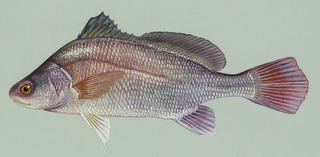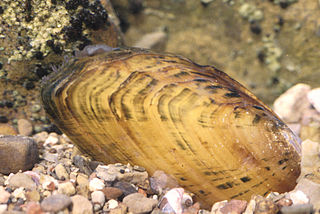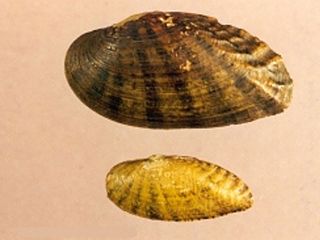
The freshwater drum, Aplodinotus grunniens, is a fish endemic to North and Central America. It is the only species in the genus Aplodinotus, and is a member of the family Sciaenidae. It is the only North American member of the group that inhabits freshwater for its entire life. Its generic name, Aplodinotus, comes from Greek meaning "single back", and the specific epithet, grunniens, comes from a Latin word meaning "grunting". It is given to it because of the grunting noise that mature males make. This noise comes from a special set of muscles within the body cavity that vibrate against the swim bladder. The purpose of the grunting is unknown, but due to it being present in only mature males and during the spawning season, it is assumed to be linked to spawning.

Echyridella menziesii, the New Zealand freshwater mussel, also known by its Māori names kākahi, kāeo, and torewai, is a species of freshwater mussel endemic to New Zealand. E. menziesii is an aquatic bivalve mollusc in the family Unionidae, the river mussels.

The Glenelg River, a perennial river of the Glenelg Hopkins catchment, is located in the Australian states of Victoria and South Australia.

Functional extinction is the extinction of a species or other taxon such that:
- It disappears from the fossil record, or historic reports of its existence cease;
- The reduced population no longer plays a significant role in ecosystem function; or
- The population is no longer viable. There are no individuals able to reproduce, or the small population of breeding individuals will not be able to sustain itself due to inbreeding depression and genetic drift, which leads to a loss of fitness.

The freshwater pearl mussel is an endangered species of freshwater mussel, an aquatic bivalve mollusc in the family Margaritiferidae.

The swan mussel, Anodonta cygnea, is a large species of freshwater mussel, an aquatic bivalve mollusc in the family Unionidae, the river mussels.

The cracking pearlymussel is an endangered species of freshwater mussel, an aquatic bivalve mollusk in the family Unionidae.

The brook floater, Alasmidonta varicosa, is a species of freshwater mussel, an aquatic bivalve mollusk in the family Unionidae, the river mussels. It measures 25.1 mm to 80.2 mm in length although other research also suggests it rarely exceeds three inches (75 mm).

Arkansia is a monotypic genus of freshwater mussels in the family Unionidae, the river mussels. The sole species in the genus is Arkansia wheeleri. Its common names are the Ouachita rock pocketbook and Wheeler's pearly mussel. The genus was named for the state of Arkansas, where the mussel was first discovered. This is a federally listed endangered species of the United States.

Cumberlandia monodonta is a freshwater mussel endemic to the United States. Currently, C. monodonta is listed as an endangered species by the U.S. Fish and Wildlife Service and the International Union for Conservation of Nature.

The birdwing pearlymussel is a rare species of freshwater mussel in the family Unionidae, the river mussels. This aquatic bivalve is native to Tennessee and Virginia in the United States. Its range has declined over 90%. It is a federally listed endangered species of the United States.

The Louisiana pearlshell, Margaritifera hembeli, is a rare species of bivalve mollusk in the family Margaritiferidae. This freshwater mussel is native to Louisiana in the United States, and was previously present also in Arkansas. It grows to a length of about 10 cm (4 in) and lives on the sand or gravel stream-bed in riffles and fast flowing stretches of small streams. Its life cycle involves a stage where it lives parasitically inside a fish. This mollusk is sensitive to increased sedimentation and cannot tolerate impoundments. Because of its limited range and its population decline, the International Union for Conservation of Nature has rated this mollusk as being "critically endangered".

Medionidus acutissimus, the Alabama moccasinshell, is a species of freshwater mussel in the family Unionidae, the river mussels. It is native to Alabama, Mississippi, Georgia, Tennessee, and possibly Florida. It is a federally listed threatened species of the United States.

Obovaria retusa is a rare species of freshwater mussel in the family Unionidae, the river mussels. Its common names include golf stick pearly mussel and ring pink. It is native to parts of the eastern and southeastern United States, but it remains in very little of its original range. There may be no viable populations left. This is a federally listed endangered species of the United States.

Toxolasma cylindrellus, the pale lilliput naiad, pale lilliput pearly mussel, or pale lilliput, is a species of freshwater mussel, an aquatic bivalve mollusk in the family Unionidae, the river mussels. Its host is the Northern studfish
Westralunio carteri is a species of freshwater mussel in the family Hyriidae. It is endemic to Western Australia. It is known by the common name Carter's freshwater mussel. This is the only species of the genus Westralunio found in Australia.
Austropyrgus pusillus is a species of minute freshwater snail with an operculum, an aquatic gastropod mollusc or micromollusc in the Hydrobiidae family. This species is endemic to western Victoria, Australia. It is found in small springs and streams that flow into the lower part of the Glenelg River.
Austropyrgus tumidus is a species of minute freshwater snail with an operculum, an aquatic gastropod mollusc or micromollusc in the Hydrobiidae family. This species is endemic to western Victoria, Australia. It is known from a few small springs and streams that flow into the lower part of the Glenelg River.
Velesunio is a genus of medium to large sized mussels in the family Hyriidae.
Euastacus bidawalus, the East Gippsland spiny crayfish, is an Australian freshwater crayfish endemic to the East Gippsland area of Victoria and the far south coast of New South Wales.















